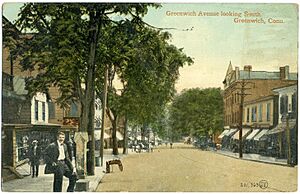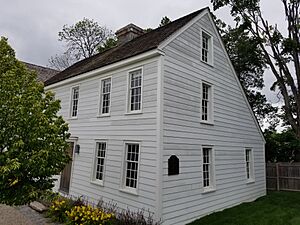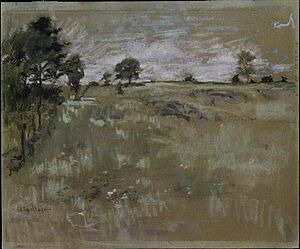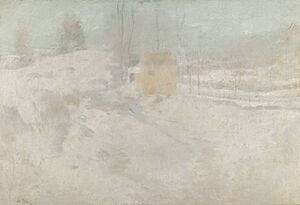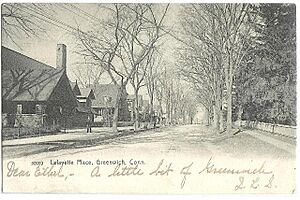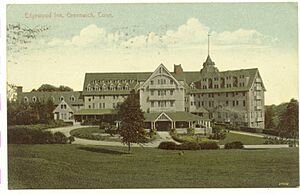History of Greenwich, Connecticut facts for kids
The history of Greenwich, Connecticut, United States, is full of interesting stories. From its early days as a Dutch settlement to becoming a popular home for artists and a modern town, Greenwich has a rich past.
Contents
Early Colonial Times in Greenwich
Greenwich began on July 18, 1640. Two men, Daniel Patrick and Robert Feake, bought land from the local Wiechquaesqueek Munsees people. They paid with "twentie-five coates" for the area now known as Old Greenwich. A place called Monakeywaygo, now "Greenwich Point," was renamed "Elizabeth's Neck" by Elizabeth Feake. She built the Feake-Ferris House there around 1645, and it still stands today!
Dutch Influence and Control
A few weeks later, Dutch soldiers from Fort Amsterdam (in what is now Manhattan) arrived. They made Patrick and Feake agree that their land was part of New Netherland, a territory of the West India Company. The Dutch called Greenwich "Groenwits" to show their control. The town became an important border between Dutch New Netherland and English New England. A small creek in the Innis Arden Country Club still marks this old boundary.
For its first 16 years, Greenwich was Dutch. The Dutch leader, Peter Stuyvesant, worked to keep Greenwich under Dutch control. He wanted to stop the English Thirteen Colonies from moving closer to Manhattan. In 1650, the Treaty of Hartford changed things, weakening Dutch power. By 1656, the New Haven Colony took control of Greenwich. Then, in 1664, the Connecticut Colony took over. The General Assembly in Hartford declared Greenwich its own separate town.
Growth and Early Economy
The first European settlers in Greenwich lived in Old Greenwich, east of the Mianus River. They planned a second community called Horseneck, on the west side of the river. This area was originally called Paihomsing by native people. European settlement there began in 1674. The name "Horseneck" was used for this area until about 1800.
Greenwich's first economy was based on livestock and leather. The town produced goods like shoes, gloves, and meat for the surrounding region.
Travel Challenges in Early Greenwich
In the 1600s and 1700s, the main road from Boston to New York, called "The Country Road" (later U.S. Route 1), went through Greenwich. But it was a very difficult road! It was rocky, hilly, and even dangerous until improvements were made in the late 1700s or early 1800s. Many travelers wrote about their tough journeys.
In 1704, Sarah Knight, riding horseback, described a "mountanos" (mountainous) hill in Greenwich that "broke my heart in ascending." This was likely the steep "Putnam Staircase," famous from the American Revolution.
A Scottish doctor, Alexander Hamilton, traveled through in 1744. He wrote that the road near Stamford was "exceeding rocky, and the roads very rough." On his way back, he was happy to cross into New York, saying, "'Farewell, Connecticut,'... 'I have had a surfeit of your ragged money, rough roads and enthusiastick people.'"
In 1750, James Birket called the road between Greenwich and Stamford a "Most Intollerable bad road." In 1786, Robert Hunter Jr. noted the "steep precipice that General Putnam galloped down." He said, "One would think to look at it, it must be a certain death."
Famous Travelers
America's Founding Fathers also used this road. In 1774, John Adams, Samuel Adams, Robert Treat Paine, and Thomas Cushing rode through Greenwich on their way to the First Continental Congress.
George Washington passed through Greenwich during the American Revolution. He returned as president in October 1789. He noted that the land seemed "strong" with lots of grass, pumpkins, and corn. He also saw many cattle, sheep, and large hogs. Washington especially noticed the many "fences of stone."
By the late 1700s, people planned to improve the road. Travelers from overseas were even avoiding this part of the road by taking boats between New Haven and New York.
Revolutionary War: The Battle of Horse Neck
During the Revolutionary War, General Israel Putnam made a very brave escape from the British. On February 26, 1779, British forces attacked Greenwich. Putnam managed to warn Stamford. His famous tricorn hat, with a bullet hole, is displayed at "Putnam's cottage" (now 243 East Putnam Avenue). This was the tavern where Putnam stayed the night before his daring ride.
Greenwich in the 1800s
Greenwich grew a lot after the New York and New Haven Railroad was built in 1849. This railroad connected the town to New York City and beyond.
Cos Cob Art Colony
The Bush-Holley House, a large house built around 1730, became a boardinghouse in 1884. It was a popular place for artists and writers. From 1890 to 1920, it became the center of the Cos Cob art colony. Famous artists like John Henry Twachtman and Julian Alden Weir taught classes there.
Other artists who spent time in Cos Cob included Leonard Ochtman, Emil Carlsen, Mina Fonda Ochtman, Elmer MacRae, George Wharton Edwards, Theodore Robinson, and Childe Hassam.
Greenwich in the 1900s
In the late 1800s and early 1900s, Greenwich became a popular resort town. It had more than a dozen inns, like Ye Old Greenwich Inn and The Edgewood Inn. The Edgewood Inn was a huge hotel with 150 rooms, built in 1902. It had modern features like steam heat, electric lights, and telephones in every room.
The Edgewood Inn offered a large dining room, a ballroom, and even its own Jersey cows for milk and cream. Guests could enjoy the Edgewood Orchestra, a billiard room, and a nine-hole golf course. There were also tennis courts and a clubhouse with a bowling alley. The hotel closed in 1940 and was later taken down.
Later 20th Century Events
In 1974, a tragic fire happened at Gulliver's Restaurant and Bar, near the border of Greenwich. Twenty-four young people died in the fire.
In 1975, 15-year-old Martha Moxley was sadly murdered in the Belle Haven community of Greenwich. This event was later written about in books and made into a movie.
In 1983, the Mianus River Bridge on Interstate 95 collapsed. Three people died in this accident. Traffic had to be sent onto local streets. This event led to investigations into the safety of other bridges built in a similar way.
Greenwich in the 2000s
Greenwich Point, also known as "Tod's Point," is a beautiful peninsula with picnic areas, a beach, and a small marina. For a long time, only Greenwich residents and their guests could visit. However, a lawsuit changed this. The Supreme Court of Connecticut decided that the beaches should be open to everyone. Greenwich then changed its rules, and now all four beaches are open to the public.
On September 11, 2001, the terrible terrorist attacks took place. Twelve residents of Greenwich were among those killed. This was more than from any other town in Connecticut. These residents were: Kevin P. Connors, Ulf Ramm Ericson, Steven Lawrence Glick, Donald F. Greene (on United Flight 93), James D. Halvorson, Joseph A. Lenihan, Cheryl Ann Monyak, Michel Adrian Pelletier, Michael Craig Rothberg, Frederick T. Varacchi, Martin P. Wohlforth, and Charles A. Zion.
Greenwich Historical Society
The Greenwich Historical Society was started in 1931. In 1957, they bought the Bush-Holley House, restored it, and opened it as a museum in 1958. In 1991, the Bush-Holley House was named a National Historic Landmark.
In 1975, the Historical Society helped create the Strickland Road Historic District. This district protects over 25 historic houses built between 1730 and 1938, including the Bush-Holley House. In 1989, the Justus Luke Bush Storehouse (built in 1805) was also purchased by the society.
Historic Places in Greenwich
Many places in Greenwich are listed on the National Register of Historic Places. This means they are important historical sites. Some of these include:
- Bush-Holley House — 39 Strickland Rd.
- Byram School — Between Sherman Ave. and Western Junior Hwy.
- Cos Cob Power Station — Roughly bounded by Metro North RR tracks, the Mianus R. and Sound Shore Dr. (Demolished in 2001, but the land remains a historic district.)
- Cos Cob Railroad Station — 55 Station Dr.
- Fourth Ward Historic District — Roughly along Church, Division, Northfield and William Sts.; and Putnam Court and Sherwood Place
- French Farm — N of Greenwich at jct. of Lake Ave. and Round Hill Rd.
- Glenville School — 449 Pemberwick Rd.
- Great Captain Island Lighthouse — Great Captain Island, SW of Greenwich Pt.
- Greenwich Avenue Historic District — Roughly bounded by Railroad, Arch, Field Point, W. Elm, Greenwich, Putnam, Mason, Havemeyer, and Bruce
- Greenwich Town Hall — 229 Greenwich Ave.
- Greenwich YMCA — 50 E. Putnam Ave.
- Josiah Wilcox House — 354 Riversville Rd.
- Knapp Tavern — 243 E. Putnam Ave.
- Merritt Parkway — CT 15 and right-of-way between the NY state line and the Housatonic R. bridge
- Methodist Episcopal Church — 61 E. Putnam Ave.
- Mianus River Railroad Bridge — AMTRAK Right-of-way at Mianus River
- New Mill and Depot Building, Hawthorne Woolen Mill — 350 Pemberwick Rd.
- Putnam Hill Historic District — U.S. 1
- Riverside Avenue Bridge — Riverside Ave. and RR tracks
- Rosemary Hall — Jct. of Ridgeway and Zaccheus Mead Ln.
- Round Hill Historic District — Roughly, jct. of John St. and Round Hill Rd.
- Samuel Ferris House — E. Putnam and Cary Sts.
- Sound Beach Railroad Station (Now called the Old Greenwich Railroad Station) — 160 Sound Beach Ave.
- Strickland Road Historic District — 19-47 Strickland Rd.
- Sylvanus Selleck Gristmill — 124 Old Mill Rd.
- Thomas Lyon House — W. Putnam Ave. and Byram Rd.
- US Post Office-Greenwich Main — 310 Greenwich Ave.


